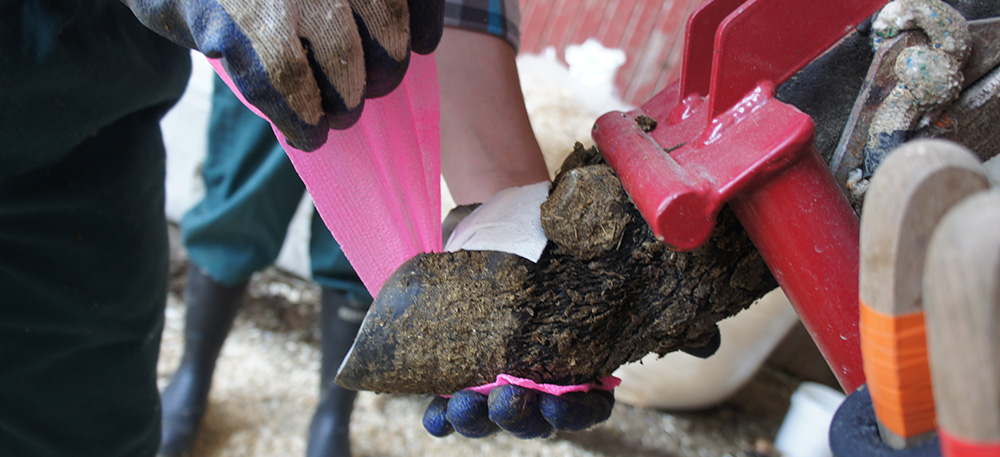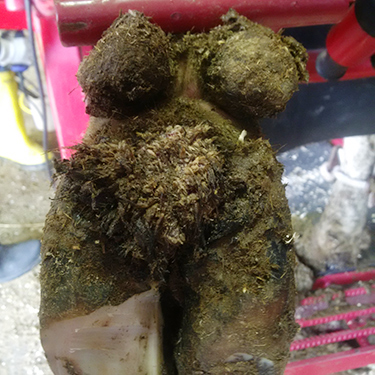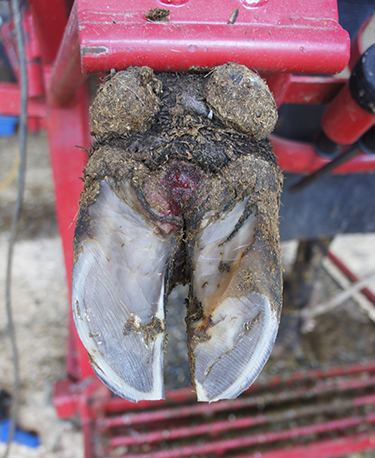
Hairy Heel Warts Affect Beef Cattle as Well as Dairy
Tips for preventing and treating hairy heel warts.
Digital dermatitis (DD), often called hairy heel warts or strawberry foot rot, can cause severe lameness in beef and dairy cattle. Doerte Doepfer, veterinarian and professor of food animal production medicine at the University of Wisconsin–Madison, has done a lot of research on this disease and offers tips for managing the problem.
“This is a worldwide infectious claw disease … associated with lameness in cattle. In North America, more than 95% of all dairy farms are affected, and it’s also becoming more common in beef herds,” she says. “It usually starts with outbreaks of severe ulcerative lesions at the border of the skin and horn tissue on the backside of the feet — mostly hind feet.”
Hairy heel warts are a multifactorial disease with a strong bacterial component. Treponemes — corkscrew-shaped bacteria that live in anaerobic (no oxygen) locations — are among the many bacteria associated with DD. There are also reports of other bacteria involved as well, including mycoplasma, porphyromonas and campylobacters. Many of these bacteria remain at the surface of the skin.
The surface bacteria damage and ulcerate the skin, so the trepomona can then penetrate and descend more deeply into the epidermis (the upper layer of skin) or even into the dermis, explains Doepfer.
“They cause inflammation that can become so severe that the skin overreacts and triggers proliferation of the upper layers of the skin,” says Doepfer. “This is what we call hairy heel warts — the tiny hair-like protrusions. These are due to chronic inflammation triggered by bacteria that reside on top of the lesions in biofilms — a big cloud of microbes.”

Copper sulfate foot baths can become too acidic and caustic, causing even more inflammation in irritated tissues. |
Risk factors associated with this disease include confined groups in high density under moist conditions, especially in cattle of mixed origins that have come together, like those in a feedlot or sale barn. Conditions such as these produce outbreaks with severe lameness. Cattle housed in such large groups make it difficult to treat animals individually with topical medications and bandaging, she says.
Systemic antibiotics — like you’d use for foot rot — are not effective. Some operations use footbaths for prevention, but Doepfer’s research shows that footbath chemicals can sometimes be detrimental.
“Copper sulfate is often used, but if the footbath becomes extremely acidified — below a pH of 3 — it becomes caustic and irritates inflamed surfaces even more. Then we see more proliferation of hairy heel wart aspects — and higher probability for outbreaks and recurrence of lesions. This is why people think the ‘bugs’ have become resistant, and the footbaths are not working.”
Joe Kavanagh, a professional hoof trimmer in Maryland who has clients in several states and has trimmed cows’ feet for 50 years, says the first cases of hairy heel wart he encountered were at a farm in Virginia in 1975.

Joe Kavanagh, a hoof trimmer of more than 50 years, recommends Kling-on Blue, a formulation of copper sulfate, zinc sulfate, organic acids and a colloid binder created for footbaths. |
“The 2-year-old cows had it so bad that their feet had grown abnormally (due to not putting any weight on the heels) and looked like square blocks,” he recalls. “The owner was the first person I’d heard of who used formaldehyde foot baths. This has been a common strategy for treatment and prevention, but I haven’t used or recommended it for the past 15 years because I discovered that formaldehyde is a carcinogen.”
Today, instead of using formaldehyde, he uses Kling-on Blue®, a formulation of copper sulfate, zinc sulfate, organic acids and a colloid binder created for footbaths. It forms a viscous solution that clings to and hardens the hoof, leaving a film on the feet. For cattle it is used once a week until improvement is seen.
“I got onto using this a couple years ago. It comes in a large bucket and is about the same consistency as paint,” he shares. “It sticks on the feet and turns them blue.”
Three years ago he started trimming feet for a farmer in Walkersville, Md. Several cattle were walking on only three legs. One cow had hairy heel wart with a swollen area as big as a softball, he recalls. Most of the cattle had hairy heel warts that went from the heel up to the dewclaw. Kavanagh wrapped the feet and came back again to rewrap.
“I told him he had to start foot baths, and that I needed to come once a week to work on those cows and get it under control,” says Kavanagh. “At first the owner complained about how much this stuff costs, but the herdsman said it worked like magic. Now their incidence of hairy heel wart is practically none. This is the only treatment I’ve found that really works.”
The copper sulfate solution that many people use may be counterproductive over time. It can interfere with soil fertility when it ends up on farm fields when the manure is spread.
“In some operations, they buy copper sulfate by the pallet for foot baths, and it was affecting their alfalfa fields,” Kavanagh cautions. “Copper is OK in the soil up to a certain level. After that you see alfalfa start to deplete; and if it gets much higher, the alfalfa ceases to grow.”
Editor’s note: Heather Smith Thomas is a freelance writer and cattlewoman from Salmon, Idaho. [Photos by Joe Kavanagh.]



